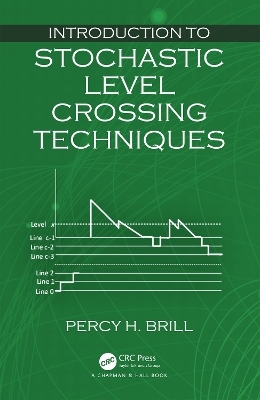
Introduction to Stochastic Level Crossing Techniques
Seiten
2023
Chapman & Hall/CRC (Verlag)
978-0-367-27735-2 (ISBN)
Chapman & Hall/CRC (Verlag)
978-0-367-27735-2 (ISBN)
Introduction to Stochastic Level Crossing Techniques describes stochastic models using the System Point Level Crossing method. This involves deriving probability density functions or cumulative probability distribution functions of key random variables, applying simple level-crossing limit theorems.
Introduction to Stochastic Level Crossing Techniques describes stochastic models and their analysis using the System Point Level Crossing method (abbreviated SPLC or LC). This involves deriving probability density functions (pdfs) or cumulative probability distribution functions (cdfs) of key random variables, applying simple level-crossing limit theorems developed by the author. The pdfs and/or cdfs are used to specify operational characteristics about the stochastic model of interest. The chapters describe distinct stochastic models and associated key random variables in the models. For each model, a figure of a typical sample path (realization, i.e., tracing over time) of the key random variable is displayed. For each model, an analytic (Volterra) integral equation for the stationary pdf of the key random variable is created−by inspection of the sample path, using the simple LC limit theorems. This LC method bypasses a great deal of algebra, usually required by other methods of analysis. The integral equations will be solved directly, or computationally. This book is meant for students of mathematics, management science, engineering, natural sciences, and researchers who use applied probability. It will also be useful to technical workers in a range of professions.
Key Features:
A description of one representative stochastic model (e.g., a single-server M/G/1 queue; a multiple server M/M/c queue; an inventory system; etc.)
Construction of a typical sample path of the key random variable of interest (e.g., the virtual waiting time or workload in queues; the net on-hand inventory in inventory systems; etc.)
Statements of the simple LC theorems, which connect the sample-path upcrossing and downcrossing rates across state-space levels, to simple mathematical functions of the stationary pdf of the key random variable, at those state-space levels
Creation of (usually Volterra) integral equations for the stationary pdf of the key random variable, by inspection of the sample path
Direct analytic solution of the integral equations, where feasible; or, computational solutions of the integral equations
Use of the derived stationary pdfs for obtaining operational characteristics of the model
Introduction to Stochastic Level Crossing Techniques describes stochastic models and their analysis using the System Point Level Crossing method (abbreviated SPLC or LC). This involves deriving probability density functions (pdfs) or cumulative probability distribution functions (cdfs) of key random variables, applying simple level-crossing limit theorems developed by the author. The pdfs and/or cdfs are used to specify operational characteristics about the stochastic model of interest. The chapters describe distinct stochastic models and associated key random variables in the models. For each model, a figure of a typical sample path (realization, i.e., tracing over time) of the key random variable is displayed. For each model, an analytic (Volterra) integral equation for the stationary pdf of the key random variable is created−by inspection of the sample path, using the simple LC limit theorems. This LC method bypasses a great deal of algebra, usually required by other methods of analysis. The integral equations will be solved directly, or computationally. This book is meant for students of mathematics, management science, engineering, natural sciences, and researchers who use applied probability. It will also be useful to technical workers in a range of professions.
Key Features:
A description of one representative stochastic model (e.g., a single-server M/G/1 queue; a multiple server M/M/c queue; an inventory system; etc.)
Construction of a typical sample path of the key random variable of interest (e.g., the virtual waiting time or workload in queues; the net on-hand inventory in inventory systems; etc.)
Statements of the simple LC theorems, which connect the sample-path upcrossing and downcrossing rates across state-space levels, to simple mathematical functions of the stationary pdf of the key random variable, at those state-space levels
Creation of (usually Volterra) integral equations for the stationary pdf of the key random variable, by inspection of the sample path
Direct analytic solution of the integral equations, where feasible; or, computational solutions of the integral equations
Use of the derived stationary pdfs for obtaining operational characteristics of the model
Percy H. Brill is a Professor Emeritus in the Management Science area of the Odette School of Business, and Adjunct Professor in the Departments of Mathematics and Statistics, at the University of Windsor in Canada.
1. Preliminaries 2. Standard M/M/1 Queue and Variants 3. M/G/1 Queues 4. M/M/c Queues 5. G/M/1 Queues 6. Inventories 7. Dams 8. Actuarial Risk Model 9. Observation of a Piecewise Cyclic Trajectory at a Random Time Point
| Erscheinungsdatum | 06.10.2023 |
|---|---|
| Zusatzinfo | 5 Line drawings, color; 54 Line drawings, black and white; 5 Illustrations, color; 54 Illustrations, black and white |
| Sprache | englisch |
| Maße | 156 x 234 mm |
| Gewicht | 671 g |
| Themenwelt | Kunst / Musik / Theater ► Design / Innenarchitektur / Mode |
| Mathematik / Informatik ► Mathematik ► Wahrscheinlichkeit / Kombinatorik | |
| Technik ► Umwelttechnik / Biotechnologie | |
| ISBN-10 | 0-367-27735-2 / 0367277352 |
| ISBN-13 | 978-0-367-27735-2 / 9780367277352 |
| Zustand | Neuware |
| Haben Sie eine Frage zum Produkt? |
Mehr entdecken
aus dem Bereich
aus dem Bereich
Buch | Softcover (2024)
Springer Spektrum (Verlag)
CHF 62,95
Eine Einführung in die faszinierende Welt des Zufalls
Buch | Softcover (2024)
Springer Spektrum (Verlag)
CHF 55,95


